Terebess
fűszerkalauz
«
vissza a Terebess Online nyitólapjára
«
vissza a Kertek
és konyhák indexlapra
Koreai konyha
A
koreai címszavak latinbetűs átírásánál a Koreai Köztársaság
Kultúra és Turizmus
Minisztériumának 2000. július 7-i szabványa volt az irányadó.
Herein, the romanization
of Korean words is based on the Korean Romanization System
adopted by the
Ministry of Culture and Tourism on July 7, 2000.
FŰSZEREK
•
Buchu
Chive,
Ciboulette alliacée
There are two kinds of chives: Korean and Chinese. Chinese
chives are wider and mostly used in Chinese dishes. The chives used in Korea are
flatter than Western chives and have a stronger flavor
•
Doenjang,
szójapaszta
fermented soybean paste, pâte de soja fermentée (condiment de base
de la cuisine coréenne)
More
pungent than Japanese miso.
Dwenjang is a traditional Korean bean paste similar
in texture and consistency to Greek hummus. Beans are ground by rock into fine
bits during which they undergo chemical change which produces a fish-like smell.
The squashed material is then put into large opaque pottery jars and left to ferment,
during which time various beneficial bacteria transform the mixture into a further
vitamin-enriched substance, similar to the way milk ferments to become yogurt.
The end product is salty and quite thick. It can be eaten in raw paste-form by
using it as a dip when eating vegetables, similar to the way Westerners dip celery
into cheese. It can also be used to make stew (dwenjang jjigae), or as a component
in miso-like soups.
http://www.haechandle.com/world/eng/contents/sauce/soybean.jsp
Cheonggukjang, erjesztett szójabab, nattó
Cheonggukjang-jjigae
Cheonggukjang (Extra Strong Soybean Paste), Ragout de pâte de soja légerement fermentée au tofu,
A stew made with a thick soybean paste called cheonggukjang (similar to Japanese natto) with dubu (soybean curd / tofu), fully fermented kimchi, and pork. This paste is thicker and has a stronger smell than the regular soybean paste (doenjang).Doenjangguk
Soybean Paste Soup, Soupe a la pâte de soja fermentée
A soup made of soybean paste (doenjang) and vegetablesDoenjang-jjigae
Soybean Paste Stew, Ragout a la pâte de soja fermentée
A stew made of soybean paste (doenjang) and various vegetables. Similar to soybean paste soup (doenjangguk) but much thickerMakjang
Soybean Paste Mixed with Barley, Pâte de soja fermentée a l'orge
A sauce made of cooked barley, glutinous rice porridge, fermented soybeans, and salt
•
Gajeun-yangnyeom,
koreai alapfűszerek: szójaszósz, zöldhagyma, fokhagyma, feketebors, őrölt piros
csiliparika, szezámolaj és szezámmag
basic seasonings: soy sauce, green onions,
garlic, black pepper, red chili pepper powder, sesame oil, and sesame seeds
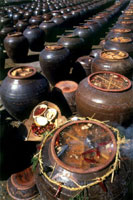
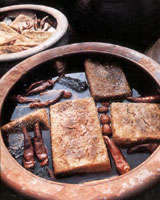
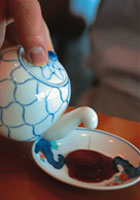
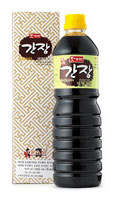
• Ganjang,
szójaszósz
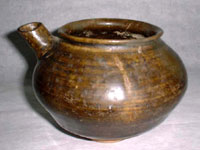
Cho-ganjang, ecetes szójaszósz
Vinegared Soy Sauce, Sauce de soja au vinaigre
A mixture of soy sauce and vinegar. This tangy dipping sauce is served with fish dishes or pan-fried vegetables and meat pattiesYangnyeom-ganjang
Seasoned Soy Sauce, Sauce de soja pour assaisonnement
A variation of soy sauce for the table or cooking. This mixture is made by adding green onions, garlic, sesame seeds, sesame oil, and black pepper or red chili pepper powder to soy sauceJangajji
Pickled Vegetables, Légumes marinés a la pâte de soja fermentée
Vegetables pickled in soybean paste (doenjang) or red chili pepper paste and served as a side dish. The most commonly used vegetables include white radish, cucumber, scallions, Korean melons (small yellow melons with a smooth rind), soybean leaves
http://www.haechandle.com/world/eng/contents/sauce/soysauce.jsp
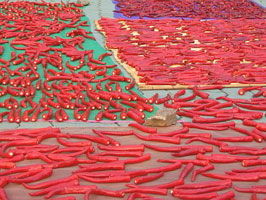
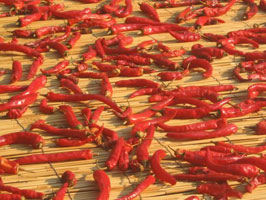
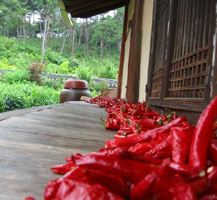
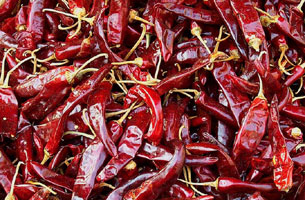
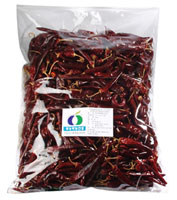
• Gochu, csilipaprika
Chili Pepper(s),
Piment
The Korean red pepper or chili is usually less spicy than its Latin
American cousin. Korean food uses both young green peppers as well as the ripe
red ones. The red peppers are dried and ground into chili powder which can be
stored for long periods
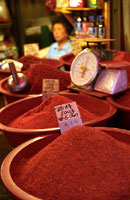
Gochutgaru, gochu-garu, fűszerpaprika-őrlemény
Red Chili Pepper Powder, Poudre de piment
A powder made of ground Korean red chili pepper. This is a major ingredient used to spice many dishes in Korean cuisineGochu-jangajji, sós zöld csilipaprika
Pickled Green Chili Peppers, Piments verts marinés
Young green chili peppers are pickled in salt and water for a week, then mixed with a salty, spicy sauceGochujeon, rántott, töltött zöld csilipaprika
Pan-fried Stuffed Green Chili Peppers,
Piments verts farcis et panés
Green chili peppers cut lengthwise and stuffed with ground beef. The stuffed peppers are then coated in flour, dipped in egg, and pan-friedGochujjim, gőzölt zöld csilipaprika
Steamed Green Chili Peppers, Piments verts panés â la vapeur
Green chili peppers coated in flour, steamed, and seasoned with soy sauce and spicesGochunnip-namul, blansírozott csilipaprika-levél
Chili Pepper Leaf Namul, Feuilles de piment assaisonnées
Side dish made of chili pepper leaves that are blanched and seasonedPutgochu, éretlen zöld csilipaprika
Young Green Chili Peppers, Piment vert
Young green chili peppers that are picked before they turn red. Eaten fresh, or chopped and added to stews or stir-fries
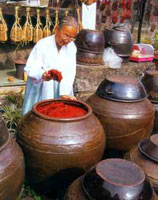
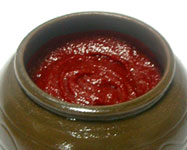
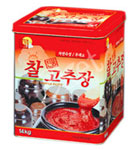
• Gochujang, csilipaszta
hot chilli pepper paste, Red Chili Pepper Paste, Pâte de piment, la jiu [kínai]
One of the main components of Korean cuisine. This spicy red paste is made of
red chili pepper powder, fermented soybeans, white rice flour and salt. It can
be used as a cooking ingredient or put on the table as a separate dipping or mixing
sauce
Gochujang
is a popular Korean condiment made from glutinous rice powder mixed with powdered
fermented soybeans and powdered red peppers. It is like a mixture of miso and
chilli powder. The paste is traditionally fermented in the sun.
Other grains
can be substitued for the glutinous rice, including normal rice, wheat and barley.
A slight sweetener (sugar, syrup or honey) is also sometimes added.
this dark
red, thick chili sauce from korea is made from chili peppers, glutinous rice,
and soybeans, and is aged for up to one year. you can find it in any korean grocery.
Gochujang
is Korea’s traditional red pepper paste. It is basically spicy, but also sweet,
salty, and of savory odor. The Meju (made of boiled beans) powder, seasoned with
salt and red pepper powder, is used to make Gochujang. The powdered malt mixed
with sticky rice or regular rice powder or flour is also used. It is one of Korea’s
most representative Jang, a kind of seasonings, which is made of fermented bean.
The bright red Gochujang sauce also enhances the appearance of food. Vegetables
or seafood, mixed with Gochujang are well-balanced in terms of nutrition.
http://www.haechandle.com/world/eng/contents/sauce/hotpepper.jsp
http://koreanrestaurantguide.com/health/health_gochu.htm
Cho-gochujang, ecetes csiliszósz,
red chili pepper paste with vinegar, sauce de piment au vinaigre
Red chili pepper paste mixed with vinegar and sugar to make a more liquid dipping sauce with a sweet and sour taste. This sauce is most commonly served with raw fish dishes
•
Gyeoja-chojang,
ecetes mustár
Mustard and Vinegar Sauce, Sauce a la moutarde et au vinaigre
Tangy sauce of mustard, vinegar and sugar. This generally accompanies cold dishes
such as raw fish or naengchae, a dish consisting of thinly sliced vegetables and
meat or seafood
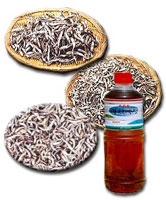
• Jeotgal, halszósz
pickled
seafood, fermented fish sauce, salted fish pickle
Jeotgal is a sauce made
of various kinds of fish or seafood, such as clams, or shrimp, that have been
pickled in salt for a long period. This sauce can be served as a side dish or
used as a seasoning for kimchi and other dishes.
Tohajeot, pácolt édesvízi rák
Pickled Freshwater Shrimps, Crevettes d'eau douce saumurées aux épices
A fish sauce made of freshwater shrimps pickled in salt, red chili pepper powder and sometimes green chili peppers, garlic, green onions and sesame seedsGuljeot, sós osztriga
Spicy Pickled Oyster, Huîtres saumurées
Oysters pickled in salt with red chili pepper powderKkolttugijeot, sós polip
Pickled Small Octopus, Calmar mariné
A variety of small octopus that has been cleaned and pickled in saltBaendaengijeot, sós hering
Pickled Large-eyed Herring, Harenguets saumurés
Sauce made of large-eyed herring that have been heavily salted and pickled to make a thick, dark fish sauce that will keep for a long time. Can be served as a side dishSaeujeot, sós garnélarák
Pickled Shrimp, Crevettes saumurées
A salty fish sauce made of baby shrimp (saeu) pickled in salt. This sauce is used to make kimchi and to season soups and other dishes with a salty flavorSeonggejeot, sós tengeri sün ikra
Pickled Sea Urchin Roe, Oursin saumuré
Yellow sea urchin roe pickled in saltEoriguljeot, pácolt osztriga
Pickled Oyster, Huîtres marinées
Fresh oysters pickled in salt, red chili pepper powder, and crushed garlicOjingeojeot, pácolt tintahal
Pickled Squid, Encornets saumurés
Slices of fresh squid pickled in salt with red chili pepper powderJaban, sós hal
Salted Fish, Poisson saumuré
Various types of fish that have been cleaned, salted and preserved. Served as side dishesJogaejeot, pácolt kagyló
Pickled Small Clams, Coquillages saumurés
Shelled clams pickled in salt. Served as a side dish
http://www.haechandle.com/world/eng/contents/sauce/kanarisauce.jsp
http://www.kccla.org/html/food_jeot.asp
•
Jocheong,
fermentált gabonaszirup
syrup made using fermented grains
•
Kkae,
szezám
Sesame
(Seeds), Sésame
Sesame seeds include basic sesame seeds and perilla, or wild
sesame seeds. In both cases, the seeds are fried before the oil is extracted,
which is used to provide flavor in Korean cuisine
Kkaesogeum, pirított szezámmagos só, gomasio [japán]
Sesame Salt, Graines de sésame grillées, moulues et salées
Sesame seeds roasted in a pan and ground with salt. One of the main seasonings in Korean cooking, this gives food a slightly buttery flavor

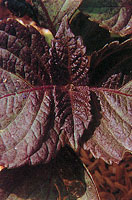
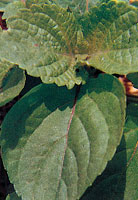
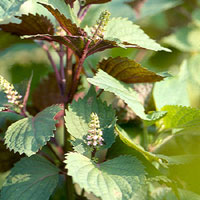
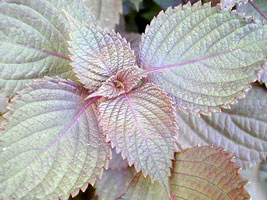
1) Kkaennip, feketecsalán - Perilla frutescens (L.) Britton var. crispa, Perilla frutescens var. acuta Kudo, Perilla frutescens var. sikokiana Nakai
wild sesame leaves, beefsteak leaf, purple mint; cserjés perilla, kínai bazsalikom, vad szezám,
This is a specialty large leaf perilla from Korea. The larger leaves are two-toned, bright green on top and light purple underneath. In Korean cuisine, the leaves are used as a wrap for cooked food. Use this distinct flavored herb for sushi, soups, salad, tempura or as an edible garnish.Kkaennip-namul
Wild Sesame Leaf Namul, Feuilles de sésame assaisonnées
A side dish made of wild sesame leaves that are blanched and seasonedKkaennip-bugak
Deep-fried Wild Sesame Leaves, Friture de feuilles de sésame a la farine de riz gluant
Wild sesame leaves coated on one side with a batter of glutinous rice starch and deep-fried. The leaves are sometimes sprinkled with sugarKkaennip-jangajji
Pickled Wild Sesame Leaves, Feuilles de sésame marinées a la sauce de soja
A pickled side dish made of wild sesame leaves marinated in soy sauce. Other versions include sesame leaves pickled in soybean paste or fish sauceKkaennipjeon
Pan-fried Wild Sesame Leaves with Fillings, Feuilles de sésame farcies et panées
Wild sesame leaves folded in half with a filling of seasoned minced beef. The stuffed leaves are coated in flour, dipped in egg, and pan-fried
2) Deulkkae, vad szezám
Wild Sesame, Sésame sauvageDeulgireum, vadszezámmag olaj
Wild Sesame Oil, Huile de sésame sauvage
Oil extracted from wild sesame seeds
3) Chamkkae, szezámmag
Sesame (Seeds), Graines de sésame
Sesame seeds are an indispensable ingredient in Korean cooking. They are either roasted and used directly or ground with a little saltChamgireum, szezámolaj
Sesame Oil, Huile de sésame
Oil pressed from roasted sesame seeds. One of the main seasonings in Korean cooking
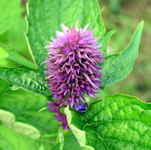
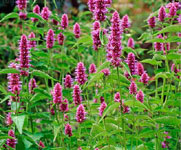
• Koreai
menta, koreai izsóp -
Agastache rugosa
(Fisch. & C.A.Mey.) Kuntze.
huo-xiang, kínai
óriás izsóp, Korean hyssop, Korean mint
Másfél méterre növő, évelő növény,
levelei ánizs ízűek
Perennial. Plant produces flavorful green mint leaves and intense
blue flowers. Young leaves smell like licorice. Excellent in salads, stir-fries,
and for seasoning meats and other dishes. Also makes a pleasing tea. Used for
long lasting cut flowers and for cooking. Attracts beneficial insects.

• Maneul,
fokhagyma
Garlic, Ail
One of the most important ingredients in Korean
cuisine
Maneul-jangajji
Pickled Garlic, Ail mariné a la sauce de soja, au vinaigre et au sucre
Whole garlic bulbs soaked in salt water for about ten days, then pickled in a mixture of soy sauce, sugar, and vinegar until the flavor has been completely absorbed by the garlic. This pickled garlic can be preserved for a long periodManeuljjong
Garlic Stems, Tiges d'ail
The young, green stem of the garlic plant is steamed or braised and served as a side dish or pickled and enjoyed over longer periodsManeuljjong-jangajji
Pickled Garlic Stems, Tiges d'ail marinées a la pâte de piment ou a la sauce de soja au vinaigre
Garlic stems pickled in red chili pepper paste or soy sauce and vinegar
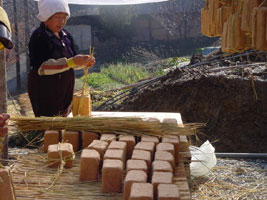
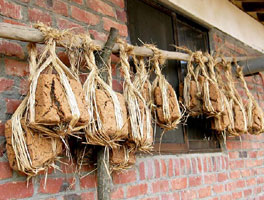
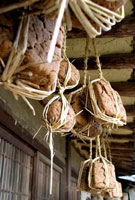
• Meju,
fermentált szójatégla
Fermented Soybean Bricks, Graines de soja fermentées
Fermented soybeans that are dried into bricks. This is the main ingredient
for soy sauce and soybean paste (doenjang)

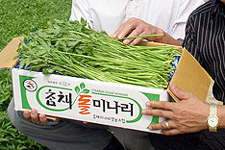
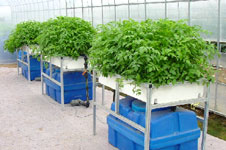
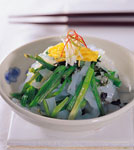
• Minari,
vízi borkóró, mételykóró - Oenanthe javanica (Blume) DC.
Korean parsley, water celery, water dropwort; seri [japán], rau cân [vietnami],
shui qin [kínai], phakchi-lom [thai]
petrezselyemre vagy zellerzöldre emlékeztető levél
Japánul: mitsuba
•
Saenggang, gyömbér
Ginger,
Gingembre
Ginger is not only used to flavor food but also to make tea and
traditional liquor
Saenggang-jeonggwa / saenggang-jeongwa
Candied Ginger, Gingembre confit
Thin slices of ginger simmered in sugar and sweet syrup until candiedSaenggang-cha
Ginger Tea, Thé au gingembre
A tea made of fresh ginger slices cooked in boiling water. Powdered instant versions are now widely available
•
Sikcho,
ecet
Vinegar, Vinaigre
•
Ssamjang, szójás csilipaszta
a
mix of doenjang and gochujang
http://www.haechandle.com/world/eng/contents/sauce/ssamjang.jsp
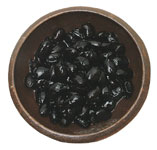
Feketebabos csiliszósz, fűszeres sötét, sós babpüré csilivel
Black bean chili sauce, mandarin: lajiao douchi
•
Ssuk,
fekete ürömfű
Mugwort, Armoise
•
Ssukgat
Crown Daisy, Estragon
A
herbal leaf vegetable with a relatively strong scent which is used by itself,
cooked and seasoned as a side dish, or added to fish soups and other stews. It
is also often used for rice wraps
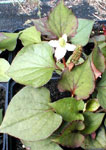
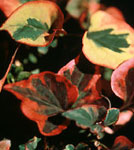
• Yagmomil, koreai koriander, ezüst szirtőr
- Houttuynia
cordata Thunb.
(eoseongcho, osongcho, kamelleon pullaentu), Chinese
lizard tail, fish mint, fish plant, fishwort, heartleaf, Himalayan spinach, lizard's
tail, edible houttuynia, heartleaf houttuynia, Vietnamese fish plant, white chaplu,
wild houttuynia, chameleon plant, stink grass [angol]; vap ca, diep ca, giap ca,
ngu tinh thao, rau dap ca [vietnami], phak kan tong, phak khao tong [thai], dokudami
[japán], ji cai [kínai]
KIMCHI
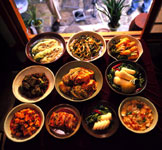
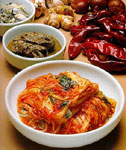
• Kimchi,
kimcsi, kimcshi
(gimchi, kimchee)
A föld alá süllyesztett edényekben erjesztett
kimcsi nevű savanyúkáposzta, a koreaiak fő nemzeti étele.

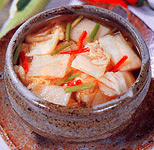
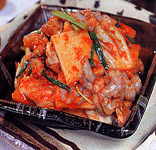
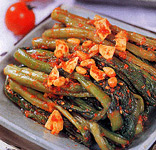
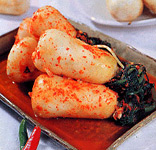
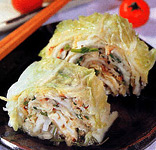
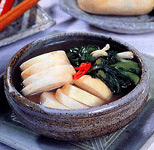
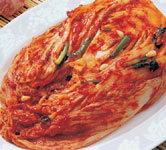
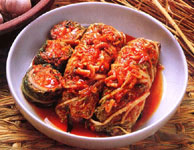
Dél-Korea
a külfölddel is szeretné megkedveltetni az évszázadok óta lakói koreaiak kedvenc
fogásának számító kimcsit. E mindenhez fogyasztott, erősen fűszerezett, csípős
savanyúságféle nélkül elképzelhetetlen a koreai konyha. Minden vidéknek és minden
háznak megvan a saját ízlése szerint készült kimcsije. Az erős paprikával, metélőhagymával,
gyömbérrel, sóval és rengeteg fokhagymával erjesztett káposzta vagy retek koleszterinmentes,
E-vitaminban és rostokban gazdag, s állítólag hatásos a rák ellen.
A csípős
savanyúságot a világ egyre több országába exportálják. Az első kimcsigyár a 70-es
években jött létre, főként a külföldön élő koreaiak ellátására, de azóta már kétszáz
fölött van a kimcsit gyártó üzemek száma. 1990 óta évi 20-30 százalékkal emelkedett
a kimcsi kivitele. A termék 70 százalékát Japánban adják el, ahol különösen keresettek
a koreai ételek. Az utóbbi években újabb piacok – köztük India, Észak-Írország,
Ghána és Szenegál – nyíltak meg a kimcsi előtt.
A kimcsimárkák közül a legjobb
a „Chonggajip Kimchi” nevű termék. Tizenhétféle kimcsit kínál, köztük kínai káposztakimcsit,
retekkimcsit, uborkakimcsit, hallal és sokféle zöldséggel töltött kínai káposztakimcsit,
valamint egy szelídebben fűszerezett, kevésbé csípős gyerekkimcsit.
A szöuli
kormány 10 milliárd vonos (12 millió dolláros) kutatási programot indított annak
érdekében, hogy a kimcsi meghódíthassa a világot. Megpróbálnak kikísérletezni
egy olyan új receptet, amely nemzetközi sikert arathat, s kutatják a kimcsinek
az egészségre gyakorolt jótékony hatását is.
A
savanyú káposztából készített, retekkel, pirospaprikával, fokhagymával és gyömbérrel
fűszerezett étel a koreai konyha szimbóluma.
E
mindenhez fogyasztott, erősen fűszerezett, csípős savanyúságféle nélkül elképzelhetetlen
a koreai konyha. Minden vidéknek és minden háznak megvan a saját ízlése szerint
készült kimcsije. Az erős paprikával, metélőhagymával, gyömbérrel, sóval és rengeteg
fokhagymával erjesztett káposzta vagy retek koleszterinmentes, E-vitaminban és
rostokban gazdag, s állítólag hatásos a rák ellen.
A csípős savanyúságot a
világ egyre több országába exportálják. Az első kimcsigyár a 70-es években jött
létre, főként a külföldön élő koreaiak ellátására, de azóta már kétszáz fölött
van a kimcsit gyártó üzemek száma. 1990 óta évi 20-30 százalékkal emelkedett a
kimcsi kivitele. A termék 70 százalékát Japánban adják el, ahol különösen keresettek
a koreai ételek. Az utóbbi években újabb piacok – köztük India, Észak-Írország,
Ghána és Szenegál – nyíltak meg a kimcsi előtt.
Molnár
B. Tamás: A kán káposztája
Magyar Nemzet, 2004. december 24., 39. oldal
Kimcsi: a koreai savanyú káposzta
http://www.origo.hu/tafelspicc/alapanyag/20121123-a-kimcsi-a-koreai-savanyukaposzta.html
Korea nemzeti étele, egyes felmérések szerint évente húsz kilót megesznek belőle. Mindenhez, minden alkalomból fogyasztják, és olyan egészséges, hogy még a madárinfluenzát is majdnem meggyógyította. Ez a kimcsi.
A kimcsi, pontosabban az őse Kínából érkezett a Koreai-félszigetre, ahol a tizenharmadik század óta fogyasztják rendszeresen. Eredetileg sózott zöldség volt, kialakulásának ugyanolyan praktikus okai vannak, mint bármilyen más savanyítás kialakulásának: tartósítani kellett az ősz végén-tél elején leszedett rengeteg káposztát, hogy ne vesszen kárba, és tavaszig fogyasztható legyen. A tartósításnak már vannak más, hatékonyabb módjai is, de a közben eltelt évszázadok alatt a kimcsi része lett a koreai konyhának. A kimcsi készítésében a hagyományok még mindig erős szerepet játszanak. Novemberben, amikor eljön a kimcsieltevés ideje (pontosabban: az év tizedik holdjának idején), hegynyi káposztahalmok közül vadásszák az emberek a legszebb, legjobb darabokat, az ízesítéshez használt zöldhagyma, szardella, apró sózott rák iránti kereslet éves csúcsokat dönt. 2010-ben, amikor a kimcsi alapanyagainak ára az egekbe szökött , és sok középosztálybeli család nem engedhette meg magának a káposzta és egyéb zöldségek megvásárlását, a koreai lapok egyenesen nemzeti tragédiát emlegettek - és a New York Times cikke alapján egyáltalán nem túloztak.
A kimcsi Korea nemzeti savanyúsága, bár amikor savanyúságot írunk, akkor nem úgy kell rá gondolni, mint a mi savanyú káposztánkra: gyakorlatilag mindenhez eszik, és mindig: reggelire éppen olyan megszokott, mint ebédre vagy vacsorára. Tulajdonképpen képtelenek nélküle meglenni, amit jól mutat az is, hogy amikor Dél-Korea első asztronautája 2008 áprilisában az űrutazásra készült, kormánya dollármilliókat ölt egy olyan kimcsi kifejlesztésébe , amelyet nyugodtan föl lehet vinni az űrbe. Külön múzeuma van, ahol több mint 187 féle történelmi kimcsiváltozatot dokumentálnak.
Az egészségre gyakorolt kedvező hatását ezerszer bizonyították: nagy a rosttartalma, kevés kalória van benne, és tele van A-, C-, B- vitaminnal. De a legkomolyabb előnye az erjedést segítő baktériumflóra (amely a joghurtban is megtalálható), ez segíti az emésztést, jótékonyan hat a bélműködésre, sőt bizonyos - egyelőre nem megerősített - kutatási eredmények szerint nagy antioxidáns-tartalma rákellenes hatású. Erre mondják az angolok, hogy superfood. A kimcsi superfood-státuszát jól mutatja, hogy a 2005-ös Nagy Madárinfluenza-hiszti idején például majdnem kikiáltották a betegség egyetlen hatékony gyógyszerének.)
A kimcsit általában novemberben kezdik készíteni, bár a hűtőszekrény elterjedése óta nincs olyan szigorúan évszakhoz kötve. A kimcsi erjedését ugyanis a hőmérséklet segítségével lehet kontrollálni, ha túl hideg van, akkor megfagy, ha túl meleg van, akkor megsavanyodik, túlerjed - mindkettő élvezhetetlen kimcsit eredményez. Hagyományosan ezért használták a jellegzetes erjesztő edényeket , amelyeknek a segítségével egyenletes hőmérsékleten lehetett tartani a zöldséget. Koreában sokan még ma is ezt használják, nem szokatlan látvány az ajtók elé kihelyezett egy vagy akár több ilyen edény, és mellé a jellegzetes, sokak által kellemetlen talált kimcsiillat, amely az erjedés folyamán keletkező gázoknak köszönhető. A sózást követően a zöldségek elkezdenek erjedni, eközben a káposztában levő cukor különböző savakká alakul, és széndioxid szabadul fel. Emiatt a karakteres illat miatt sokan egyébként külön hűtőszekrényt rendszeresítenek a savanyúság számára, nehogy a többi étel átvegye a zamatot.
Noha a legismertebb és legkedveltebb formájában kínai kelből készül, gyakorlatilag mindenféle zöldséget lehet ilyen módon savanyítani, az uborkától kezdve a karfiolon keresztül a szójacsíráig.
Kimcsi (koreai savanyú zöldség)
http://buvosszakacs.blog.hu/2007/12/06/nepek_kaposztai4-5 kisebb kínai kel külső leveleit leszedjük, a belső részt hosszában négyfelé vágjuk. Két-három napig a napon vagy a kályha mellett szokták szárítani, mert ez növeli a természetes édességét. Ezután széles edénybe tesszük, alaposan besózzuk, vízzel felöntjük, szobahőmérsékleten tartjuk: 1 kiló káposztára 5 deka sót és 2 deci vizet vegyünk. Ez az első fázis, amely intenzív sózást igényel. 8-10 óráig állni hagyjuk, közben egyszer megforgatjuk. Amikor már megereszkedett, kimossuk, a nedvességet szelíden kinyomkodjuk.
Ezután elkészítjük a következő keveréket: 1 kiló káposztára számítva 2 gerezd fokhagymát és egy kis darab gyömbért finomra vágunk, összekeverjük (az erősségétől függően) kettő-négy evőkanál paprikapehellyel. Ha nem kapunk az Ázsia-boltban, magozzunk ki piros paprikát, és éles késsel vágjuk finomra. Teszünk még hozzá sót (egy kiló káposztára ekkor már elég 8-10 gramm), és feleannyi cukrot.
Ezt a fűszerkeveréket összevegyítjük egy kilóra 30 deka jégretekkel – amelyet először fél centi vastag karikákra, majd fél centi széles hasábokra vágunk – és csíkokra darabolt újhagymával. Az eredetibe mindenképpen kerül valamilyen sózott, szárított rák. Ezt mi kilónként két-három darab finomra vágott szardellával helyettesítjük. Kilónként fél pohár (1,25 dl) langyos vizet adunk hozzá.
Óvatosan összevegyítjük a káposztát és a retkes-hagymás-fűszeres keveréket, a fűszereket beledörzsölgetjük a káposztába. Tegyük érlelőedénybe, a tetejére helyezzünk nehezéket, zárjuk le légmentesen. Hagyjuk szobahőmérsékleten erjedni. A harmadik, negyedik és ötödik napon alaposan kavarjuk meg. A kimcsi az erjedés kezdetén a negyedik-ötödik napon a legjobb. Az érett káposztát csavaros üvegbe tesszük és hűtőszekrénybe tesszük, hogy leállítsuk a további erjedést, ott is tároljuk. Egy öttagú koreai család több száz így elkészített káposztafejet fogyaszt el a tél folyamán.
http://www.kimchi.or.kr/eng/sitemap/sitemap.htm
http://www.sogang.ac.kr/~burns/cult96/s950118.html
Dongchimi:
Radish Kimchi in Water
http://www.agrotrade.net/html/agrafood/9603/foodculture_9603_2.htm
http://www.kimchi.or.kr/eng/recipe/kimchi_make.html
http://www.lemis.com/~grog/recipes/kimchi.html
http://www.jasonunbound.com/kimchi.html
http://www.asiafood.org/kimchi.cfm
Kimchi Museum
http://www.lifeinkorea.com/culture/kimchi/kimchi.cfm
http://www.kimchikorea.net
http://www.kimchi.gwangju.kr/english/event/ex2.asp
http://www.koreanska.se/types-of-kimchi.htm
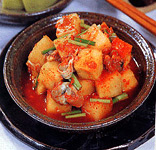
Kkakdugi
Diced Radish Kimchi, Kimchi pimenté de navets coupés en dés
Kimchi made of diced white radish. The radish pieces are first salted and then mixed with the traditional kimchi sauce of red chili pepper powder, fish sauce, garlic, and green onions
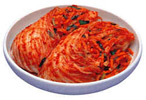
Tontbaechu-kimchi
Whole Chinese Cabbage Kimchi, Kimchi de chou chinois aux épices
The basic kimchi made in large quantities in early winter. Whole Chinese cabbages are first salted and then a kimchi sauce made of julienned white radish, red chili pepper powder, garlic, green onions, and fish sauce is spread between the layers of cabbage
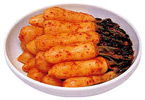
Chonggak-kimchi
Whole Radish Kimchi, Kimchi de jeunes radis
A kimchi made of young white radishes used whole with the stems and leaves. The radishes are seasoned with red chili pepper powder, green onions, garlic, ginger and fish sauce, then left to cure. It literally means bachelor kimchi, because the stems are reminiscent of the long ponytails of unmarried men in traditional times. Also called altari kimchiKongip-kimchi
Soybean Leaf Kimchi, Kimchi de feuilles de soja
A variation of kimchi made of salted soybean leaves mixed with sliced radish and fish sauce and laid between the cabbage leavesPa-kimchi
Green Onion Kimchi, Kimchi de ciboulette
A kimchi made with lightly salted green onions seasoned with pickled anchovy sauce, garlic and red chili pepper powderGat-kimchi
Mustard Leaf Kimchi, Kimchi de moutardelle
A kimchi made of gat, a kind of mustard leaf. The stems and leaves are seasoned with pickled anchovy sauce. The strong flavor of the mustard leaf and the anchovy is what makes this kimchi popularGodeulppaegi-kimchi
Godeulppaegi Kimchi, Kimchi de 'godeulppaegi'
A strongly flavored kimchi made with a wild flowering plant (godeulppaegi) which has been soaked in water for up to ten days to remove its bitter tasteNabak-kimchi
Radish Water Kimchi, Kimchi aux morceaux de navet et de chou
A slightly pink kimchi made with Chinese cabbage, thinly sliced white radish, a large amount of water, and minari (a leafy vegetable resembling parsley) to give this kimchi a distinctive a flavorDongchimi
Radish Kimchi in Water, Kimchi de navet a l'eau
A kimchi made of whole white radishes, green onions, garlic, ginger and salt water. The radishes are rolled in salt and put in a big jar with the other ingredients and salt water. After being cured, this kimchi has plenty of flavorful water which is chillMak-kimchi
Mixed Kimchi, Kimchi de chou et de navet
A kimchi prepared with sliced Chinese cabbage (instead of whole) and white radish mixed with green onions, garlic and pickled shrimp sauceMucheong-kimchi
Radish Stem Kimchi, Kimchi de feuilles de radis
A kimchi made of the green part of radish stems and leavesMul-kimchi
Water Kimchi, Kimchi a l'eau
A variation of kimchi in water. Both the water and the crunchy pickled vegetable in it are eaten. This kind of kimchi includes sliced radish and cabbage kimchi (nabak-kimchi), kimchi made with whole baby white radishes and their stalks (yeolmu-kimchi)

Baechu-kimchi
Chinese Cabbage Kimchi, Kimchi de chou chinois
The most basic type of kimchi, made of whole Chinese cabbages. The cabbages are cut in half and then salted or soaked in salt water. After the leaves have lost some of their water, a mixture of julienned white radish, garlic, red chili pepper powder, green onions
Interestingly, although baechu kimchi (Chinese cabbage kimchi) is now the most common variety, it was developed relatively recently. Chili peppers were introduced to Korea (by way of Japan) only in the early 17th century, and thus Kimchi utilizing red peppers would have been popularized some years after that (200 years, by one estimate). In addition, the introduction of Chinese cabbage probably did not occur until the 19th century; Kimchi before then would have been made from more indigenous vegetables.
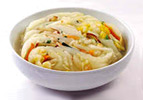
Baek-kimchi
White Chinese Cabbage Kimchi, Kimchi blanc non pimenté
A version of cabbage kimchi with very small amounts of red chili pepper powder used only for seasoning the julienned radishes in the sauceBossam-kimchi
Wrapped Kimchi, Kimchi farci aux épices variées
A kimchi made of quartered cabbages with kimchi seasonings spread between the layers of leaves and wrapped separately in a large cabbage leaf. The fist-sized bundles are put into jars and left to season together.Buchu-kimchi
Chive Kimchi, Kimchi de ciboulette alliacée
A kimchi made of chives mixed with fish sauce, red chili pepper powder, crushed garlic and some glutinous rice starchBineul-kimchi / mubineul-kimchi
Stuffed White Radish Kimchi, Kimchi de navets farcis
A kimchi made of whole white radishes with diagonal slits that are stuffed with sliced radish and seasoningsSeokbakji
Chinese Cabbage and Radish Kimchi, Kimchi de chou et de navet coupé
A kimchi made of pre-salted Chinese cabbages and white radishes cut into pieces then mixed in kimchi spices or fish sauceSobagi-kimchi
Stuffed Kimchi, 'Sobagi' kimchi
A kimchi made of vegetables such as cucumber, white radish, eggplant, or chili pepper that are slit lengthwise and stuffed with spicy fillingSunmu-kimchi
Turnip Kimchi, Kimchi de navet a la mode de Ganghwa
A kimchi made of turnips (smaller than the usual white radish used in Korea). This is a specialty of the Ganghwado region
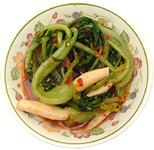
Yeolmu-kimchi
Young Summer Radish Kimchi, Kimchi de feuilles de jeunes radis
A kimchi made of young summer radish (smaller roots with larger leaves). This kimchi has a lot of water and is lightly seasonedOi-sobagi / oi-sobagi-kimchi
Stuffed Cucumber Kimchi, Kimchi de concombre farci
A kimchi made of cucumbers cut into three to four sections, slit lengthwise, and stuffed with a filling of green onions, garlic, ginger and red chili pepper powderJang-kimchi
Soy Sauce Kimchi, Kimchi a la sauce de soja
A kimchi made with soy sauce. The young leaves in the heart of the cabbage are sliced and mixed with julienned white radish, red chili threads, garlic, green onions, ginger, minari (Korean parsley), and mushrooms. All the ingredients are then seasoned tog
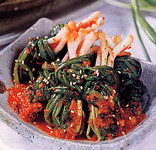
Jjokpa-kimchi
Spring Onion Kimchi, Kimchi de ciboulette
A kimchi made of lightly salted spring onions mixed with kimchi seasonings
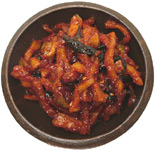
Mumallaengi-kimchi, aszalt retek kimcsi
dried radish kimchi, Julienne de navets séchés
GYÜMÖLCS
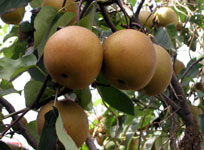
• Bae,
körte, nashi
Korean Pear, Poire
One of the most popular fruits in Korea,
the Korean pear is bigger and rounder than its Western counterpart. It also has
a very crunchy texture and more juice. Sliced pear is added to many Korean dishes
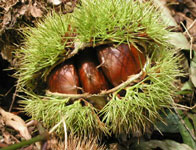
• Bam,
szelídgesztenye
Chestnut(s), Marron (châtaigne)
The chestnut is used
in diverse ways in Korean cuisine. Chestnuts are peeled and eaten raw as a companion
for alcoholic drinks and put into cold dishes and even kimchi.
Saengyul
Peeled Fresh Chestnuts, Marrons crus épluchés
Chestnuts peeled and served freshBamcho
Candied Chestnuts, Marrons glacés
Peeled chestnuts simmered in water with sugar or honey until candiedYullan
Mashed Chestnut Sweets, Boulettes de purée de marrons aux pignons
Mashed cooked chestnuts mixed with cinnamon and sugar, molded into chestnut shapes, and rolled in ground pine nuts or cinnamon
•
Boksunga,
őszibarack
Peach
•
Chamoe, sárgadinnye
Korean Honey Melon,
Melon jaune
A small, oval melon with a smooth, yellow rind and white ridges
running lengthwise. Along with the watermelon, this is one of the most common
summer fruits
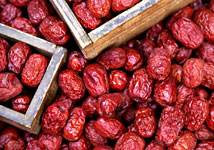
• Daechu,
jujuba
Jujube(s), Jujubes
Jujubes are also known as Korean dates. They
can be eaten fresh and green off the tree but more often are dried and used in
desserts as a garnish, or steeped in traditional herb teas to counter the bitter
taste of the medicine
Daechu-saenggangcha
Jujube and Ginger Tea, Thé aux jujubes et au gingembre
A tea made of simmering ginger and jujubes (Korean dates) and then adding honey. This tea is taken as a cold remedyDaechucha
Jujube Tea, Thé aux jujubes
A traditional tea made of jujubes (Korean dates), sweetened with honey and garnished with pine nutsJoran
Mashed Jujube Sweets, Boulettes de purée de jujubes aux pignons
Steamed and mashed jujubes (Korean dates) mixed with sugar and molded back into their original shape. The balls are rolled in ground pine nuts to hold their shape and prevent them from sticking to each other
•
Eunhaeng,
ginkómag
gingko, noix de ginkgo
•
Gam, hurma,
datolyaszilva - Diospyros kaki Thunb.
persimmon, kaki
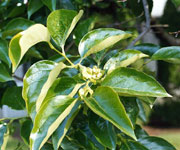
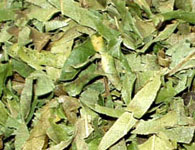

Hurmalevél tea
persimmon leaf tea
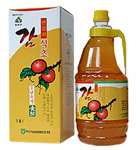
Gam-sikcho, kakiszilva ecet
persimmon vinegarGotgam
Dried Persimmon, Kaki séché
Persimmons that are peeled and fully dried in the open air. This very sweet, flavorful dried fruit is eaten on its own as a dessert or a snack and is also used in rice cakes or dessert drinks like persimmon punch
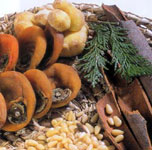
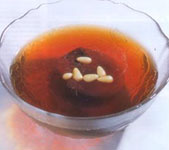
Sujeonggwa, aszalt kakiszilva kompót fahéjjal és gyömbérrel ízesítve
Cinnamon Punch with Dried Persimmon, Boisson sucrée au kaki séché
A sweet punch is made of ginger, cinnamon sticks and sugar simmered together in water. Dried persimmons are added after cooling and the punch is served with a few pine nuts floating on top. One of Korea’s most popular dessert drinksHwajeon, pan-fried dough topped with petals of balsam, persimmon flower and cockscomb
•
Gwapyeon, kandírozott gyümölcs
Traditional
Candied Fruit, Gâteau traditionnel aux fruits confits
Candied fruit that has
been cooked in boiling water and strained, then left to harden in attractive shapes
Suksilgwa
Glazed Fruits and Nuts, Fruits confits
Fruits and nuts, especially chestnuts, jujubes (Korean dates), and ginger, that have been simmered in honey, sweet syrup and sugar until glazedJeonggwa
Candied Fruits or Roots, Gâteaux aux fruits ou racines cuits au miel
Traditional sweet treats made of fruits or roots candied in honey or syrup
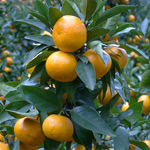
• Gyul, mandarin
Mandarin Orange,
Clémentine
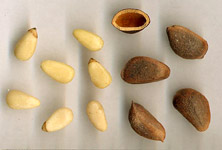
•
Haisung, koreai cirbolyafenyő-mag
- Pinus koraiensis
http://en.wikipedia.org/wiki/Image:KoreanPineSeeds.jpg
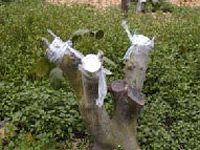
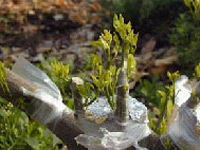
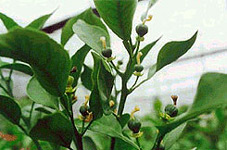
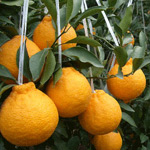
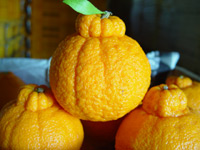
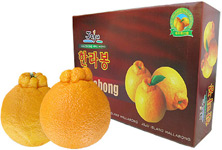
•
Hallabong,
"orros"
édesnarancs - Citrus
sphaerocarpa, [Citrus unshiu Marcov × C. sinensis Osbeck] × C.
reticulata Blanco
Könnyen
hámozható, mézédes narancs, nagyszemű, 20 dkg-osra nő, csak Korea déli
csücskében a Jeju-szigeten (Csedzsu) terem, nevét az ottani Halla-hegyről kapta,
formája emlékeztet rá. Bonyolult termesztési technikája és fagyérzékenysége miatt
ára háromszorosa a többi citrusénak. Japánban dekopon a neve.
http://www.agrotrade.net/html/agrafood/9904/cover.htm
•
Jat,
fenyőmag
Pine Nut(s), Pignons
Jat-gangjeong
Pine Nut Cookies, Gâteau de riz frit au miel et aux pignons
Cookies made with rice flour that are deep-fried, dipped in sweet syrup, and topped with pine nutsJat-baksan
Pine Nut Candy, Friandise aux pignons
A sweet treat made of pine nuts mixed with maltose syrup, sugar and honey and left to harden
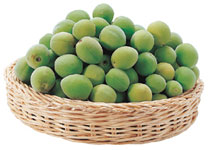
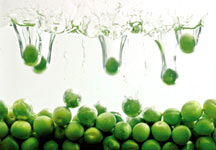
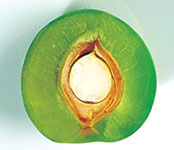
• Maesil,
zöldbarack, ume
Japanese Plums, Prunelle
Japanese plums are smaller and
harder than regular plums. These green plums are very fragrant and are often used
to make a sweet wine but can also be pickled in salt and sugar. Recently, they
have been added to soybean paste (doenjang) and red chili pepper
Maesilju
Japanese Plum Liquor, Liqueur de prunelles
A liquor made by adding Japanese plums and sugar to soju
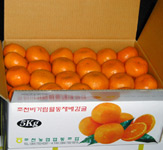
• Milgam,
mandarin
•
Mogwa, kínai birs
Chinese quince,
coing
This fruit has a beautiful fragrance but is very hard and cannot be
eaten fresh. Chinese quince are usually diced and mixed in honey or sugar. This
mixture can be added to hot water to make a sweet fruit tea and is also used in
fruit punch drinks
•
Omija
'Omija'
(fruit de la famille âmaximowiczia sinensisâ)
The fruit of the Chinese magnolia
vine, used in teas, wine, punches, and as a medicine. Omija literally means “five
tastes” and is said to be all the flavors: sweet, salty, bitter, sour, and spicy
•
Sagwa, alma
Apple, Pomme
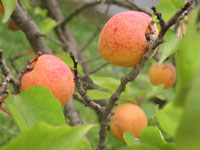
• Salgu, kajszibarack
Apricot,
Abricot
Salgupyeon
Jellied Apricots, Abricots confits
Apricots that have been cooked in water, strained, and simmered in sugar or honey. Starch is added to make a jelly
•
Subak, görögdinnye
Watermelon, Pasteque
• Ttalgi,
földieper
strawberry, fraise
•
Ttangkong,
földimogyoró
peanut, cacahouete
•
Yuja, keserű narancs
'Yuja' citron,
agrume coréen
Yuja-jeonggwa
Glazed Citron | f. 'Yuja' glacé
Citron peel cooked in water then simmered in sugar water until glazed. The citron fruit is added during the glazing process
• Chwi-namul
Wild Aster Namul, 'Chwi' (légume vert) assaisonné
A side dish made with blanched wild aster (a vegetable found in the mountains)
that has been seasoned or stir-fried with other ingredients
•
Deodeok (todok), lándzsalevelű
harangfolyondár - Codonopsis lanceolata
gyökeréből kimcsi készül
•
Doraji (toraji),
hírharang, léggömbvirág - Platycodon grandiflorus
gyökeréből kimcsi készül
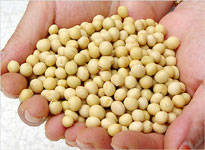
• Kong, szójabab
Soybean,
Soja
Soybeans are used to make soy sauce, dubu (soybean curd / tofu), and
oil
•
Kongnamul, szójacsíra
Soybean Sprout
Namul, Germes de soja
Sprouts about 5-7 centimeters long made from soybeans
soaked in water. An inexpensive and popular ingredient for many Korean dishes
Kongnamul-muchim
Seasoned Soybean Sprout Namul, Germes de soja assaisonnés
Blanched bean sprouts seasoned with green onions, garlic, soy sauce and sesame oil. This is one of the most common side dishes served in Korean homes
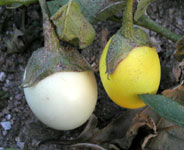
• Gaji, tojásgyümölcs, padlizsán
Eggplant,
Aubergine
Gaji-namul
Eggplant Namul, Aubergines assaisonnées a la coréenne
Eggplant steamed then marinated in soy sauce, green onions, garlic, red chili pepper powder, sesame oil and vinegarGajiseon
Stuffed Eggplant,
Aubergines farcies mijotées au bouillon
Eggplants cut lengthwise, filled with seasonings, and simmered in brothGajijeon
Pan-fried Eggplant, Aubergines panées
Eggplant slices coated with flour, dipped in egg, and pan-fried
•
Geotjeori
Fresh Kimchi, Salade
de chou a la sauce de soja
The leaves of Chinese cabbage or other leafy vegetables
dressed in soy sauce and spices and served fresh as a side dish
•
Goguma, édesburgonya
Sweet
Potato, Patate douce
•
Gogumasun-namul
Cooked Sweet Potato
Stems, Tiges de patate douce sautées
Side dish made with the stems of the
sweet potato. The stems are blanched and seasoned, then lightly fried with oil
•
Gomyeong, köretek
Garnish,
Garnitures variées
Popular Korean garnishes include thinly red chili pepper
threads, julienned egg yolk and whites (the yolks and whites are separated, beaten,
and pan-fried like crepes), minced jujubes (Korean dates), chestnuts, walnuts,
ground pine nuts, cooked gingko nut
•
Gosari, saspáfrányhajtás - Pteridium
aquilinum var. latiusculum
warabi [japán]
Fiddlehead(s), Fougeres séchées
Young fern shoots are picked, blanched, drained, and then dried in the open
air. The dried fiddleheads are used in soups or soaked in water and then pan-fried
to make a side dish (fiddlehead namul)
Gobi, királypáfrány - Osmunda japonica
zenmai [japán]
•
Guksu, főtt metélt tészta
Noodle(s), Nouilles
Made from a multigrain flour, these thin noodles are cooked in boiling water,
drained, and eaten in a broth or spicy sauce
•
Minari, vízi borkóró, mételykóró -
Oenanthe javanica (Blume) DC.
water dropwort; seri [japán], rau cân [vietnami], shui qin [kínai], phakchi-lom
[thai]
petrezselyemre vagy zellerzöldre emlékeztető levél
•
Miyeok, tengeri moszat
Seaweed, Algue,
wakame
Miyeokguk
Seaweed Soup, Soupe aux algues ('miyeok')
A soup made of seaweed that is soaked, drained, then cooked in a broth of beef or dried anchovies. This soup is traditionally given to mothers after childbirthMiyeokssam
Seaweed Wraps, Riz enveloppé dans des algues blanchies
Blanched fresh seaweed cut into strips which are used to wrap spoonfuls of rice and other foodsGim
Dried Laver, Algues séchées
This seaweed has sheet-like fronds and grows along the western and southern coasts of Korea. It is dried in sheets, then lightly oiled, salted, and roasted. Gim is usually eaten wrapped around a spoonful of rice
(nori?)Gim-muchim
Seasoned Laver, Feuilles d'algues séchées assaisonnées
Dried laver toasted, broken into small pieces, then seasonedGimbap
Dasima
Rice Rolls in Laver, Rouleaux de riz farcis entourés de feuilles d'algues
To make this colorful roll, rice is spread on a dried laver sheet with beef, fried egg, pickled radish, and various steamed vegetables, then rolled and cut into slices
Kelp, Laminaires
Boiled and served cold with red chili pepper paste to make a vegetable for ssam, cooked to make a soup broth, or deep-fried as a side dish or snack
Dasimassam / naldasimassam
Kelp Wraps, Riz enveloppé dans une feuille de laminaire
Slices of fresh kelp used as a wrap for rice and other foods, dipped in pickled anchovy sauce before eating
• Mu, daikon, jégcsapretek - Raphanus sativus
•
Naengi
Shepherd’s purse, Capselle
a white-flowered plant in the cabbage family, which grows in fields and is
picked and eaten in spring
Naengi-namul / naengi-namul-muchim
Capselles a la sauce de soja
A vegetable side dish made of naengi (shepherd’s purse) parboiled and mixed with a seasoned soy sauce
•
Nogak-saengchae
Seasoned Overripe
Cucumbers, Concombre mur saumuré et épicé
Overripe cucumbers that have turned
yellowish are peeled and soaked in salt water. The salted cucumbers are squeezed
to eliminate excess water, then chopped and spiced with red chili pepper paste,
vinegar, green onions, garlic, black pepper, and sugar
•
Nokdu, mungóbab
Mung Bean,
Lentilles vertes
Mung beans are ground to make mung bean jelly, mung bean
and vegetable pancakes, rice cake coating, and mung bean porridge, similar to
a Chinese congee. Mung bean sprouts are also eaten as a vegetable side dish
Nokdumuk
Mung Bean Jelly, Gelée de lentilles vertes
A firm jelly made with mung bean starch. Also called cheongpomukNokdu-bindaetteok
Mung Bean Pancake, Galettes de lentilles vertes et de riz aux légumes
A fried pancake made of mung bean flour and a little glutinous rice flour cooked with pork, sliced kimchi, green bean sprouts, green onions and garlic
•
Dallae, vad fokhagyma
Wild
Scallion, Ail sauvage
A long, thin spring herb with a flavor similar to green
onions. It is eaten mixed with various spices as a side dish, in soybean paste
(doenjang) stew, or as a seasoning for sauces
•
Namul, ízesített főzelék
seasoned
vegetables, vegetable side dishes, légumes assaisonnés
The most popular way
to enjoy vegetables in Korea is to prepare them as a namul by blanching them and
then sauteeing them with seasonings and spices.
Side dishes of vegetables
or wild leafy greens. There are two main methods of preparation : stir-frying
the vegetables with spices, and blanching the vegetables and then seasoning them.
The most common seasonings are soy sauce, garlic, sesame seeds, sesam oil
Namul include all edible herbs, leaves, roots and vegetables, but also refers to side dishes consisting of roots and greens that have been blanched and seasoned. The cooking method and seasonings vary according to the ingredients. Summer squash, cucumbers and bellflower root (doraji) are salted in advance and then stir-fried with seasonings. Mung bean sprouts, spinach, crown daisy, chili pepper leaves, wild sesame leaves and other green leaves are blanched and then fried or seasoned by hand. Soybean sprouts are blanched in salt water and seasoned. White radishes are julienned and seasoned first, then cooked in boiling water. The main seasonings used are soy sauce, garlic, sesame seeds, sesame oil and green onions, but some namul dishes are also flavored with red chili pepper powder, black pepper, red chili pepper paste and pickled shrimp sauce. Popular namul dishes include bellflower root namul, soybean sprout namul, and naengi namul.
•
Muchim, fűszeres ételek
seasoned
or spiced dishes
These dishes consist of vegetable, root, and occasionally
seafood ingredients tossed in a spicy dressing and served as a side dish. These
dishes are the same as namul dishes and the two terms are often used interchangeably.
•
Po, szárított ételek
dried food
A
popular snack, po are thin strips or sheets of dried meat or fish, similar to
jerky. The dried beef is called yukpo and the dried fish is called eopo.
Mareun-anju
Dry Snacks, Amuse-bouche (assortiment de poisson et viande séchés)
Dry snacks, such as dried fish, dried beef or other meats, and dried peas and beans. Served with traditional liquors and other alcoholGeoneopo
Whole fish cleaned, salted, and dried in the open air
•
Dubu,
szójasajt
soybean
curd, tofu, pâté de soja
Sundubu
Soft Dubu, Flan de tofu ('sundubu')
Soft dubu (soybean curd / tofu) before thickeners are added to harden the curd to its usual texture
•
Deodeok gyökér
A perennial
vine, the deodeok (bonnet bellflower) root has a distinctive smell. It is grilled
or steamed as a side dish and is also used as medicine
Deodeok-gui
Grilled Deodeok, Racines de deodeok grillées
Deodoek root marinated in soy sauce and red chili pepper paste and then grilledDeodeok-kimchi
Deodeok Kimchi, Kimchi aux racines de deodeok
A kimchi made of deodeok root, white radish and Chinese cabbage.Deodeok-muchim
Spicy Deodeok, Racines de deodeok a la pâte de piment Deodeok root shredded into small pieces by hand and seasoned with a red chili pepper paste sauceDeodeok-saengchae
Deodeok Salad, Salade pimentée aux racines de deodeok
Deodeok root mixed with red chili pepper powder and other seasoningsDeodeok-jangajji
Deodeok Pickles, Racines de deodeok a la pâte de piment
A side dish of deodeok roots pickled in red chili pepper paste
•
Doraji
Bellflower Roots, Racines
de campanule
The roots of the bellflower are either grilled or seasoned and
served raw
Doraji-namul
Bellflower Root Namul, Racines de campanules cuites a l'ail
A side dish of bellflower roots cooked in water, drained, then sauteed with chopped green onions, garlic, and sesame saltDoraji-jeonggwa
Candied Bellflower Roots, Racines de campanules glacées Whole bellflower roots (doraji) peeled and simmered in a mixture of water, honey, and sugar until candied
•
Dotori, tölgymakk
Acorn,
Gland
Dotori-naengmyeon
Chilled Acorn Noodle Soup, Nouilles de farine de gland froides
Noodles made of acorn starch served in a chilled broth and garnished with seasoned vegetablesDotoritteok
Acorn Cake, Gâteaux de farine de gland
A steamed cake made of acorn starch, millet flour, and a coating of ground beans and red beansDotorimuk
Acorn Starch Jelly, Gelée de farine de glands
A firm jelly made of acorn starch, often served with a seasoned soy sauce
•
Dolnamul
Dollamul, Orpin
Sedum,
a fleshy-leafed perennial that is found in the mountains. The tender young plants
are often added to kimchi made in the spring or are made into a spring salad as
a side dish
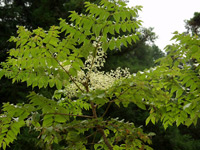
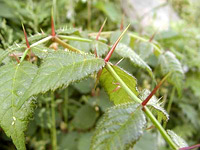
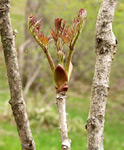
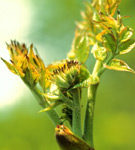
•
Dureup,
mandzsu arália - Aralia elata (Miq.) Seemann
taranoki [japán], Japanese
angelica tree
Tavaszi friss hajtásait kirántják.
•
Ramyeon
Instant Noodles, Nouilles
instantanées (âramyeonâ)
Very popular instant noodle soup that can be cooked
in just four or five minutes
•
Mandu, gombóc
Dumpling(s),
Raviolis
Dumplings consisting of thin, flat pieces of dough filled with vegetables,
meat, and spices. These dumplings are either cooked in boiling water, steamed,
or fried in oil
Mandu-jeongol
Dumpling Hot Pot, Marmite de raviolis aux légumes
A hot pot of dumplings, meat, and vegetables in a meat brothMandut-guk
Dumpling Soup, Soupe aux raviolis
A soup of dumplings in a clear meat broth topped with slices of beef and julienned egg garnishJjin-mandu
Steamed Dumplings, Raviolis a la vapeur
Dumplings cooked in a steamer.
•
Meowi-namul
Butterbur Stem Namul,
Tussilages sautés et assaisonnés
Blanched stems of the butterbur (sweet colt’s
foot) sauteed and seasoned
•
Memil, hajdina
Buckwheat, Sarrasin
Buckwheat seeds are ground into a fine flour which is used to make noodles
or a firm buckwheat jelly
Memil-guksu
Buckwheat Noodles, Nouilles de sarrasin froides
Cooked buckwheat noodles chilled and served with a dipping sauce made of dried fish and seaweedMemilmuk / memilmuk-muchim
Buckwheat Jelly, Gelée de sarrasin (assaisonnée)
A firm jelly made of buckwheat that is sliced, topped with a seasoning sauce and shredded dried laver, and mixed with chopped kimchiOnmyeon
Buckwheat Noodle Soup, Nouilles dans un bouillon chaud
A warm buckwheat noodle soup in a beef broth served with kimchi. Also refers to all hot noodles
•
Myeolchi, szárított ajóka
Dried
Anchovies, Anchois séchés
Anchovies are sun-dried and prepared differently
according to their size. The large anchovies are used to make broth; the mid-sized
ones are braised in soy sauce, and the smallest ones are pan-fried. Fresh anchovies
are also pickled in salt
Myeolchi-bokkeum
Sauteed Dried Anchovies, Anchois séchés sautés a la sauce de soja sucrée
A side dish of dried anchovies pan-fried with soy sauce or red chili pepper paste and glazed with sugar or maltose syrup
•
Mu, jégcsapretek
White Radish,
Navet
An important ingredient in kimchi, white radish is also braised and
used in soups
Mumallaengi-muchim
Seasoned Dried Radish, Julienne de navets séchés et assaisonnés
A side dish of julienned white radish that has been dried in the open air (a process that preserves vegetables over the winter) then briefly soaked in water and seasonedMumallaengi-jangajji
Dried Radish Pickles, Julienne de navets séchés et marinés a la sauce de soja
Dried white radish slices pickled in soy sauce and mixed with other seasonings. Dried chili pepper leaves that have been soaked in water are often added as wellJjanmu
Pickled Radish, Navets saumurés
Autumn white radishes pickled whole in salt and kept until the following summer
•
Muk, zselatin
Jelly, Flan de fécules
diverses
A firm jelly made of acorn, mung bean, or buckwheat starch boiled
in water and cooled until it sets
Muk
Dotorimuk, tölgymakk
Cheongpomuk, mungóbab
Memilmuk, hajdina
•
Mullyeot
Maltose Syrup, Sirop
d'orgeat
A syrup made of malt and rice or other cereals. This thick, sweet
syrup is used in many dishes
•
Banchan
Side Dishes, Plats d'accompagnement
A range of dishes eaten with rice to add flavor. The basic Korean meal consists
of a bowl of rice, a soup or stew and some side dishes.
Mitbanchan
Assorted Side Dishes, Petits plats d'accompagnement
Side dishes such as cucumber pickles, beans or beef braised in soy sauce are made in large batches and served over a period of time. Most Korean households have an assortment of these dishes at any given time to provide a tasty accompaniment to rice
•
Bakogari-namul, szárított tökhéj
Gourd
Peel Namul, Courges séchées mijotées avec assaisonnement
A side dish made
of dried gourd skins that are soaked, seasoned, and cooked over low heat until
the flavor is fully absorbed
•
Bap, főtt rizs
Cooked Rice,
Bol de riz nature
Rice that has been washed, brought to a boil and simmered
until cooked. In Korean, the expression ‘eating rice’ means to have a meal. Rice
is unquestionably the essence of a Korean meal.
Boribap, árpás rizs
Barley Rice, Riz a l'orge
Rice cooked with barley, árpagyönggyel kevert főtt rizsSungnyung, pörköltrizs tea
Browned Rice Tea, Boisson chaude au gratin de riz
A tea made of the browned rice from the bottom of the rice pot. Water is poured into the pot and boiled until the slightly burnt rice on the bottom softens and mixes with the water. This popular drink is served hot after mealsJuk, rizskása
Porridge, Porridge de riz
Porridge made of rice or other grains simmered in water until thick. Served as a main dish or in smaller portions as an appetizerMieum, rizsnyák
Rice Gruel, Bouillie de riz légere
A thin, clear gruel made of one part rice and ten parts water. This is mostly given to patients because it is easy to drinkChapssal, ragacsos rizs
Sweet Rice, Riz gluant
Sweet rice is stickier than plain white rice and is often used to make rice cakeTwibap
Puffed Rice, Pop-corn de riz
Crispy rice flakes puffed like popcornNurungji, pörkölt rizs
Browned Rice, Gratin de riz ('nurungji')
Crusty, browned rice made from the scorched part of steamed rice that is usually stuck to the bottom of the rice pot. It is eaten in hot water as a browned rice tea after a meal or fried as a crispy snack. Also called nurunbap
•
Baechu, kínai kel
Chinese Cabbage,
Chou chinois
As the main ingredient in kimchi, white cabbage is halved and
its layers of leaves are filled with a spicy mixture. Similar cabbages can be
found in Japan and China
•
Baechu-geotjeori
Spicy Chinese Cabbage
Salad Kimchi, Feuilles de chou chinois saumurées et assaisonnées
A salad made
of Chinese cabbage leaves that are separated and salted, then tossed in a dressing
of red chili pepper powder, green onions, garlic, soy sauce, sesame oil and some
sugar
•
Beoseot, gomba
Mushroom, Champignons
The most commonly used mushrooms in Korean cuisine are the
Mogi, fafüle gomba
wood ear mushrooms
(very dark and thin, used mostly in Chinese and Korean cuisine)Neutari, laskagomba
oyster mushroomsPaengi, enoki gomba
enoki mushrooms
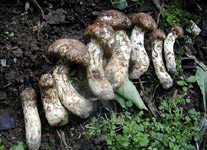
Songi, matsutake gomba
fragrant pine mushrooms
http://sanjigi.netian.com/songi2.jpg
http://www.nfcf.or.kr/forest/images/prod_img_songi_class.jpgSsari, ssaribeoseot, korall gomba
coral mushroom, clavaire
The caps are said to taste like chicken and the stems like abaloneYangsongi, csiperke gomba
Button Mushroom, Champignon de Paris
•
Bulgogi
Bulgogi (Korean Barbecue),
Barbecue coréen (grillade de bouf mariné)
Thin slices of beef marinated in
a mixture of soy sauce, sugar, green onions, garlic, black pepper, sesame seeds,
and sesame oil and grilled at the table. Bulgogi is one of Korea’s most popular
beef dishes
•
Sangchu, saláta
Lettuce, Laitue
•
Susu, köles
Millet, Sorgho
•
Sukju-namul, mungóbab csíra
Mung
Bean Sprout Namul, Germes de soja blanchis et assaisonnés
A side dish of mung
bean sprouts blanched in salt water and seasoned
•
Sigeumchi, paraj
Spinach, Epinards
•
Siraegi, szárított reteklevél
Dried Radish Leaves, Feuilles de chou et de radis séchées
Leaves of white
radish or Chinese cabbage that have been dried to preserve them through the winter
and used later in soups, stews or seasoned side dishes
Siraegi-namul
Cooked Dried Radish Leaf Namul, 'Namul' de feuilles de chou et de radis séchées
Dried radish or Chinese cabbage leaves that have been cooked in water, seasoned, and sauteed lightly in oil. Ground dried anchovies or sesames are some of the unique seasonings used to flavor this dish
•
Sseumbagwi, vadsaláta
Wild Lettuce,
Laiteron
A wild leafy green with edible roots and long, thin leaves that are
slightly bitter. This is most commonly harvested from the mountains in the spring
•
Yeongeun. lótuszgyökér
Lotus Roots,
Racine de lotus
Lotus roots are pan-fried, made into porridge, and also dipped
in honey to make sweets
•
Yeolmu, hónapos retek
Young Summer
Radish, Jeune radis
•
Oi, uborka
Cucumber(s), Concombre
Oi-jangajji
Cucumbers Pickled in Soy Sauce or Red Chili Pepper Paste, Concombre salé
Salted cucumbers pickled in a mixture of vinegar, soy sauce and sugar, or put into a jar of red chili pepper paste or soybean paste (doenjang). Keeps for a long period and is served as a side dishOiji, sósvizes uborka
Cucumbers Pickled in Salt Water, Concombre saumuré
Cucumbers pickled by pouring hot salt water over them and letting them sit for a long time
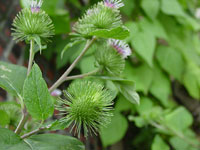

• Ueong,
bojtorján - Arctium lappa L.
burdock, racine de bardane; gobo [japán]
Fiatal
főgyökerét zöldségként használják.
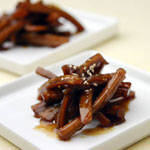
Ueong-jorim
Glazed Burdock, Racine de bardane mijotée a la sauce de soja
Burdock simmered in soy sauce, sesame oil, and sugar until glazed and garnished with sesame seeds and red chili pepper threads
•
Wonchuri-namul
Day Lily Namul, Lis
jaunes blanchis et assaisonnés
Blanched day lily stems seasoned with soybean
paste (doenjang), red chili pepper paste, green onions, garlic, sesame oil, and
sesame salt. This is a spring dish
•
Insam, ginszeng
Ginseng
A
root famous for its medicinal properties that is also used for cooking. Fresh
ginseng is called susam and is served sliced as a special appetizer or dessert.
It can also be made into a juice. Dried ginseng is most often used to make tea
Insam-jeonggwa
Candied Ginseng, Ginseng au sirop
Sliced ginseng simmered until soft, then glazed in water with honey, sweet syrup, sugar and salt until candiedInsamju, ginszeng-likőr
Ginseng Wine, Liqueur de ginseng
Liquor fermented with ground ginseng or flavored by adding a pouch of ginseng to wine that has already been madeInsamcha, ginszeng tea
Ginseng Tea, Thé au ginseng
A tea traditionally made by simmering ginseng, jujubes (Korean dates), and peeled chestnuts. Recently, an instant powdered version has become widely available. Ginseng tea is served with pine nuts on topMisam-muchim
Seasoned Young Ginseng, Petites racines de ginseng assaisonnées
Thin, young ginseng roots seasoned with a spicy soy sauce or vinegared red chili pepper pasteSusam-jeonggwa
Candied Fresh Ginseng, Friandise de ginseng au miel
Pieces of ginseng simmered in sugar water then candied with sweet syrup or honey
•
Juksun, bambuszrügy
Bamboo Shoots,
Pousse de bambou
Jugyeom, bambusz-só
Bamboo Salt, Sel de bambou
A flavored salt made by filling a hollow bamboo stem that has been cut into sections with plain salt. The sections are then scorched in a hot oven and the salt is removed for use. This salt is said to have a superior taste and medicinal benefits
•
Chamnamul
Cham Namul, Feuilles de
'cham' assaisonnées
A wild leafy green with a strong scent, blanched or served
fresh with various seasonings as a side dish
•
Gamja, burgonya
Potato, Pomme de
terre
•
Hangwa, sütemény
Traditional Sweets,
Assortiment de gâteaux coréens
Many types of traditional Korean sweets and
cookies. They vary according to ingredients and preparation method
•
Yeot
Malt Candy, Sirop de malt
A sweet, sticky candy made of hardened maltose syrup and sweet glutinous rice.
This candy has the texture of toffee
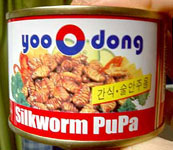
• Boondaegi,
selyemhernyó báb
•
Saengseon-chobap, sushi
Raw
Fish on Rice
Similar to Japanese sushi, thin slices of raw fish and a small
amount of wasabi are placed on top of bite-sized lumps of white rice that has
been cooked with a little vinegar and sugar
ITALOK
•
Shikkye, dansul,
édes rizsmalátalé
(shikae), fermented rice punch, made from barley malt and
glutinous rice
Boisson sucrée fermentée a base de riz
A traditional sweet
dessert drink made of malt and rice. When served, there are often rice grains
floating on top. Also called dansul
•
Cheongju
Clear
Rice Wine, Liqueur de riz (blanche)
A clear, refined rice wine made from a
thicker rice wine that has been strained several times. This type of rice wine
is similar to Japanese sake
•
Jindallaesul
Azalea
Liquor, Liqueur d'azalée
A sweet liquor made by adding azalea petals and sugar
to soju. Also called dugyeonju
•
Nokcha
Green Tea, Thé vert coréen
A tea made from tea leaves picked when tender and
green, then dried carefully to preserve the green color
Nokchabap
Green Tea Rice, Riz au thé vert
Rice cooked in green tea instead of plain waterJakseolcha
Sparrow's Tongue Green Tea, Thé vert 'jakseol'
A green tea made with the new leaves of that year. Jakseol literally means "sparrow's tongue" and refers to the shape of the tea leaf
•
Yulmucha
Yulmu
Tea, Thé aux grains de yulmu
A hot drink made by adding roasted ground Job’s
tears (this white powder has a nutty flavor) into hot water with sugar or honey
•
Insamju
Ginseng
Wine, Liqueur de ginseng
Liquor fermented with ground ginseng or flavored
by adding a pouch of ginseng to wine that has already been made
•
Insamcha
Ginseng Tea, Thé au ginseng
A tea traditionally made by simmering ginseng,
jujubes (Korean dates), and peeled chestnuts. Recently, an instant powdered version
has become widely available. Ginseng tea is served with pine nuts on top
•
Danggwi-cha
Angelica Tea, Thé a l'angélique
A tea made from the root of the angelica plant
•
Chikcha
Arrowroot Tea, Thé a la racine de maranta
A tea made with the juice pressed
from wild arrowroot. Powdered arrowroot can also be used
•
Gyeolmyeongjacha
Gyeolmyeongja
Tea, Thé des 'yeux brillants' (thé a base de graines d'une plante de la famille
'cassia nomame')
A tea made with the dried seeds of the sicklepod plant, which
can be served hot or cold. This tea is known for its clarifying effects on the
liver and eyes
•
Gyepicha
Cinnamon
Tea, Thé â la cannelle
Tea made of dried whole cinnamon sticks boiled with
a small amount of ginger. This tea is usually garnished with minced jujubes (Korean
dates).
•
Gukhwaju
Chrysanthemum
Rice Wine, Liqueur de chrysantheme
Rice wine flavored by adding dried chrysanthemum
petals to the wine during maturation
•
Yakju
Clear
Rice Wine, Alcool de riz médicinal
A rice wine made from steamed rice that
has gone through several fermentation stages. Ingredients in traditional medicine
are also added, giving this liquor its literal name of "medicinal wine" (yak means
medicine)
•
Soju
'Soju'
(eau-de-vie coréenne)
A clear, distilled liquor made of rice, sweet potatoes
and other ingredients similar to vodka. Along with makgeolli, this is the most
popular alcoholic beverage in Korea and is also the base liquor for many other
drinks. The alcohol content is 20-25%
•
Beopju / gyeongju- beopju
Rice
Wine (Gyeongju Style), Alcool de riz de qualité de Gyeongju
First created
by a Gyeongju family, this high quality rice wine is made from both white and
glutinous rice. The alcohol content is approximately 15%
•
Boricha
Barley
Tea, Thé a l'orge
Roasted barley cooked in water. Served both hot and cold,
this is one of the most common beverages found in Korean homes and restaurants
and is often served instead of water
•
Mogwacha
Chinese
Quince Tea, Thé au coing
A sweet tea made of thin slices of Chinese quince
that have been preserved in honey
•
Makgeolli
Thick
Rice Beer, Alcool de riz ('makgeolli')
A thick, milky rice beer made by adding
yeast and water to steamed white rice, glutinous rice, barley and wheat flour
and leaving it to ferment at a set temperature. It is also called farmers’ beer
•
Dongdongju
Thick Rice Beer, Alcool de riz ('dongdongju')
A beer made by fermenting rice
with yeast. In Korean, the term dongdongju suggests something floating, referring
to the rice grains that are often floating on top
•
Munbaeju
'Munbaeju'
(alcool traditionnel a base de millet et de sorgho)
A traditional liquor made
of malted wheat, rice, and millet which originates in the Pyeongyang region of
North Korea. It is famous for its fragrance which is said to resemble the munbae
rose, hence its name. The alcohol content is around 40%
•
Saenggang-cha
Ginger
Tea, Thé au gingembre
A tea made of fresh ginger slices cooked in boiling
water. Powdered instant versions are now widely available
•
Misutgaru
Grain
Powder Drink Mix, Farine de riz gluant grillé
A powder made from steamed rice
that has been dried, toasted, and ground. It is mixed with cold water and sugar
or honey to make a popular summer drink
http://blog.naver.com/swinter8?Redirect=Log&logNo=130000620855
http://test.clickkorea.org/dic_food.asp
http://www.agrotrade.net/html/agrafood/9602/foodculture_9602.htm
http://hvg.hu/gasztronomia/20101108_koreai_konyha_recept